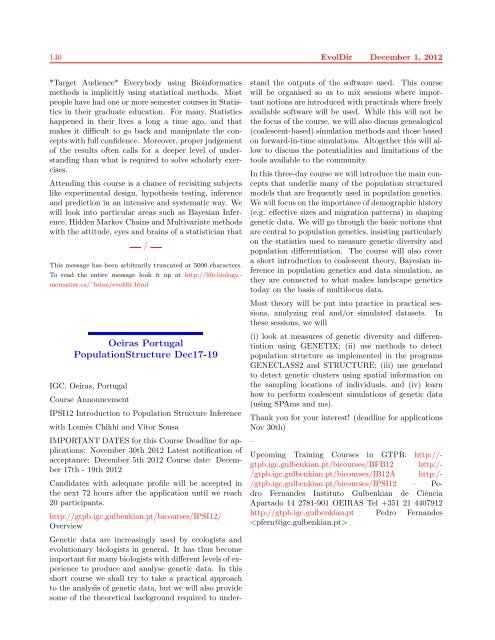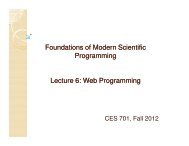E v o l D i r
E v o l D i r
E v o l D i r
You also want an ePaper? Increase the reach of your titles
YUMPU automatically turns print PDFs into web optimized ePapers that Google loves.
140 EvolDir December 1, 2012<br />
*Target Audience* Everybody using Bioinformatics<br />
methods is implicitly using statistical methods. Most<br />
people have had one or more semester courses in Statistics<br />
in their graduate education. For many, Statistics<br />
happened in their lives a long a time ago, and that<br />
makes it difficult to go back and manipulate the concepts<br />
with full confidence. Moreover, proper judgement<br />
of the results often calls for a deeper level of understanding<br />
than what is required to solve scholarly exercises.<br />
Attending this course is a chance of revisiting subjects<br />
like experimental design, hypothesis testing, inference<br />
and prediction in an intensive and systematic way. We<br />
will look into particular areas such as Bayesian Inference,<br />
Hidden Markov Chains and Multivariate methods<br />
with the attitude, eyes and brains of a statistician that<br />
/<br />
This message has been arbitrarily truncated at 5000 characters.<br />
To read the entire message look it up at http://life.biology.-<br />
mcmaster.ca/˜brian/evoldir.html<br />
Oeiras Portugal<br />
PopulationStructure Dec17-19<br />
IGC, Oeiras, Portugal<br />
Course Announcement<br />
IPSI12 Introduction to Population Structure Inference<br />
with Lounès Chikhi and Vitor Sousa<br />
IMPORTANT DATES for this Course Deadline for applications:<br />
November 30th 2012 Latest notification of<br />
acceptance: December 5th 2012 Course date: December<br />
17th - 19th 2012<br />
Candidates with adequate profile will be accepted in<br />
the next 72 hours after the application until we reach<br />
20 participants.<br />
http://gtpb.igc.gulbenkian.pt/bicourses/IPSI12/<br />
Overview<br />
Genetic data are increasingly used by ecologists and<br />
evolutionary biologists in general. It has thus become<br />
important for many biologists with different levels of experience<br />
to produce and analyse genetic data. In this<br />
short course we shall try to take a practical approach<br />
to the analysis of genetic data, but we will also provide<br />
some of the theoretical background required to under-<br />
stand the outputs of the software used. This course<br />
will be organised so as to mix sessions where important<br />
notions are introduced with practicals where freely<br />
available software will be used. While this will not be<br />
the focus of the course, we will also discuss genealogical<br />
(coalescent-based) simulation methods and those based<br />
on forward-in-time simulations. Altogether this will allow<br />
to discuss the potentialities and limitations of the<br />
tools available to the community.<br />
In this three-day course we will introduce the main concepts<br />
that underlie many of the population structured<br />
models that are frequently used in population genetics.<br />
We will focus on the importance of demographic history<br />
(e.g. effective sizes and migration patterns) in shaping<br />
genetic data. We will go through the basic notions that<br />
are central to population genetics, insisting particularly<br />
on the statistics used to measure genetic diversity and<br />
population differentiation. The course will also cover<br />
a short introduction to coalescent theory, Bayesian inference<br />
in population genetics and data simulation, as<br />
they are connected to what makes landscape genetics<br />
today on the basis of multilocus data.<br />
Most theory will be put into practice in practical sessions,<br />
analyzing real and/or simulated datasets. In<br />
these sessions, we will<br />
(i) look at measures of genetic diversity and differentiation<br />
using GENETIX; (ii) use methods to detect<br />
population structure as implemented in the programs<br />
GENECLASS2 and STRUCTURE; (iii) use geneland<br />
to detect genetic clusters using spatial information on<br />
the sampling locations of individuals, and (iv) learn<br />
how to perform coalescent simulations of genetic data<br />
(using SPAms and ms).<br />
Thank you for your interest! (deadline for applications<br />
Nov 30th)<br />
–<br />
Upcoming Training Courses in GTPB: http://gtpb.igc.gulbenkian.pt/bicourses/BFB12<br />
http:/-<br />
/gtpb.igc.gulbenkian.pt/bicourses/IB12A http:/-<br />
/gtpb.igc.gulbenkian.pt/bicourses/IPSI12 – Pedro<br />
Fernandes Instituto Gulbenkian de Ciência<br />
Apartado 14 2781-901 OEIRAS Tel +351 21 4407912<br />
http://gtpb.igc.gulbenkian.pt Pedro Fernandes<br />

















